92404i Setup Will Continue Windows 2008
| C H A P T E R 3 |
| Install Windows Server 2008 Operating System |
This chapter provides information about installing the Windows Server 2008 and Windows Server 2008 R2 Operating Systems (OS).
| Note - If you want to create a RAID for your disk, the recommended procedure is to create a RAID before you install the OS. For more information, see Configure RAID Controller in the BIOS Setup Utility. |
This chapter includes the following topics:
- Task Map for the Windows Server 2008 Installation
- Install Windows Server 2008 Using Local or Remote Media
- Install Windows Server 2008 Using PXE Network
Task Map for the Windows Server 2008 Installation
Use TABLE 3-1 to preview the installation process defined as a series of tasks. The table defines the required tasks, describes them, and provides pointers to the instructions for performing that task.
| Step | Task | Description | Relevant Topic(s) |
|---|---|---|---|
| 1 | Review installation prerequisites | Verify that all applicable requirements are met for installing an operating system to a server. |
|
| 2 | Choose an installation method | Evaluate and select an installation method that meets the needs of your infrastructure. |
|
| 3 | Ensure that the BIOS factory defaults are set | Verify that the factory default settings in the BIOS are set prior to performing the operating system installation. |
|
| 4 | Gather the Windows installation media | The Windows OS is shipped with the CD and DVD media and documentation that you will need to install the Windows OS. |
|
| 5 | (Optional) Configure RAID Controller | Follow the instructions to implement RAID using the BIOS Setup utility. |
|
| 6 | Perform the Windows 2008 OS installation | Follow the instructions in this chapter to install the Windows 2008 operating system. |
|
| 7 | Install driver(s) and supplemental software post installation, if applicable | If necessary, install the updated server-specific drivers and the server supplemental software. |
|
| Note - The complete Microsoft Windows operating system installation process is not documented in this section. This section walks you through the steps for booting the Windows Server 2008 media, installing drivers (if necessary) at boot, and partitioning the drive. For additional information, consult the Microsoft Windows 2008 Product Documentation at: http://www.microsoft.com/windowsserver2008/en/us/product-documentation.aspx |
Install Windows Server 2008 Using Local or Remote Media
The following procedure describes how to boot the Windows Server 2008 operating system from local or remote media. It assumes you are booting the Windows installation media from one of the following sources:
- Windows 2008 CD or DVD (internal or external CD/DVD)
- Windows 2008 ISO image (network repository)
| Note - If you are booting the installation media from a PXE environment, refer to Install Windows Server 2008 Using PXE Network for instructions. |
Prior to performing the installation, the following requirements must be met:
- All applicable installation prerequisites for installing an operating system should have been met. For further information about these prerequisites, see TABLE 1-2 Installation Prerequisites.
- An installation method (for example: console, boot media, and installation target) should have been chosen and established prior to performing the installation. For more information about these setup requirements, see Installation Methods.
After completing this procedure, you will need to perform the post installation tasks as described in Post Installation.
|
1. Ensure that the installation media is available to boot.
For example:
- For distribution CD/DVD. Insert the Windows 2008 Distribution media (CD labeled #1 or the single DVD) into the local or remote USB CD/DVD-ROM drive.
- For ISO image. Ensure that the ISO images are available and that the ILOM Remote Console application is aware of the first ISO image location.
For additional information about how to set up the installation media, see TABLE 1-4 Installation Boot Media
2. Reset or power on the server.
For example:
- From the ILOM web interface, select Remote Control --> Remote Power Control, then select the Power Cycle option from the Host action drop-down list box.
- From the local server, press the Power button on the front panel of the server to turn the server off, then press the Power button again to turn the server on.
- From the ILOM CLI on the server SP, type: reset /SYS
The BIOS screen appears.
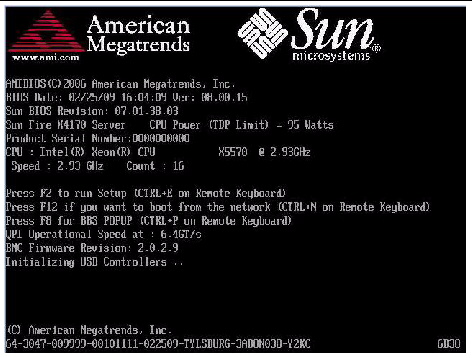
3. When the Press F8 for BBS POPUP prompt appears on the BIOS POST screen, press F8 to select a boot device.
The Boot Device dialog appears.
| Note - The dialog that appears in your installation may be different depending the type of disk controller installed in your server. |
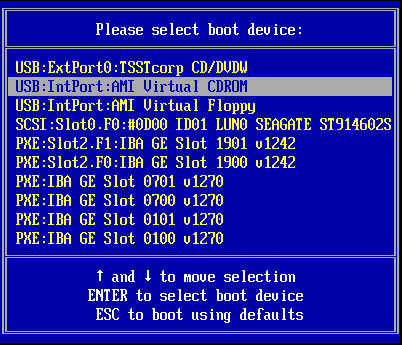
4. In the Boot Device dialog, select the menu item according to the Windows media installation method you elected to use and press Enter.
For example:
- If you elected to use the Windows Local delivery method, select CD/DVDW.
- If you elected to use the Sun ILOM Remote Console delivery method, select Virtual CDROM.
5. When prompted with Press any key to boot from CD, press any key.
The Windows installation wizard starts.
Continue the Windows installation wizard until the Installation Type dialog appears.
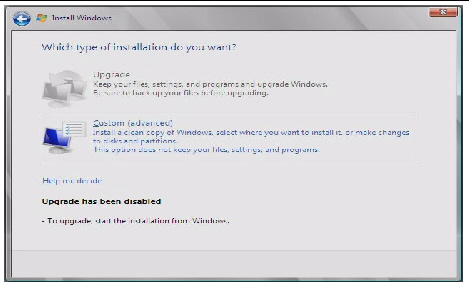
6. In the Installation Type dialog, click Custom (advanced).
The Where Do You Want To Install Windows dialog appears.
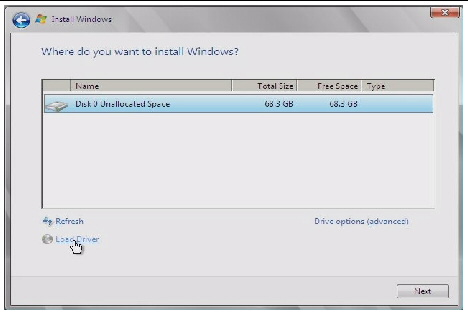
7. In the Where Do You Want To Install Windows dialog, do one of the following:
- If you do not want to override the Windows Default partition information, click Next then skip to Step 9.
- If you do want to override the Windows default partition information, click the Drive Options (advanced) option and proceed to Step 8.
 | Caution - Formatting or re-partitioning a pre-existing partition will destroy all data on the partition. |
The Where To Install Windows dialog appears.

8. In the Where to Install Windows dialog, do the following:
a. Click Delete to delete the existing partition.
A confirmation window appears.
b. Click Ok to confirm the partition deletion.
c. Click New to create the new partition.
d. Change partition size settings as needed, and then click Apply.
The partition is created.
e. Click Next and proceed to the next step.
The Windows installation begins.
The server will reboot multiple times during the installation process. This process could take several minutes.
9. When the Windows installation is complete, Windows starts and prompts you to change the user password.
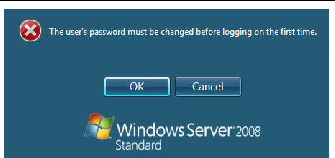
10. In the user password dialog, click OK and set up the initial user login account.
| Note - Windows Server 2008 enforces stronger password schemes for user accounts. Password standards include restrictions on length, complexity and history. For more details, click the Accessibility link at the account creation page. |
After the initial user account is created, the Windows Server 2008 desktop appears.
11. Proceed to Post Installation.
Install Windows Server 2008 Using PXE Network
This section explains the initial information you will need to install the Windows Server 2008 operating system over an established PXE-based network via a customer-provided Windows Deployment Services (WDS) image.
Topics included in this section:
- Before You Begin
- Install Windows Server 2008 Using PXE
Note that the procedure presented in this section documents the initial steps to install Windows 2008 over the network using a Windows Deployment Services (WDS) image. Specifically, it explains the steps for selecting the server PXE network interface card that will be communicate with your WDS installation server. For further information about using a WDS image to install the Windows Server 2008 operating system, see Microsoft's Windows Deployment Services documentation.
After completing this procedure, you will need to perform the post installation tasks as described in Post Installation.
Before You Begin
- To use PXE to boot the installation media over the network, you must:
- Configure the network (NFS, FTP, HTTP) server to export the installation tree.
- Configure the files on the TFTP server that are necessary for PXE booting.
- Configure the Sun server MAC network port address to boot from the PXE configuration.
- Configure Dynamic Host Configuration Protocol (DHCP).
- To use a WIM image to perform the installation, you must:
- Create the WIM installation image.
Follow the WIM installation instructions in the Windows Server 2008 documentation.
- Add the required system device drivers to the WIM installation image.
For instruction, see Appendix A Incorporate Sun Fire Drivers Into a WIM or RIS Image.
- Obtain a WIM Administrator password.
|
1. Reset the power on the server.
For example:
- From the ILOM web interface, select Remote Control --> Remote Power Control, then select the Power Cycle option from the Host action drop-down list box.
- From the local server, press the Power button on the front panel of the server to turn the server off, then press the Power button again to turn the server on.
- From the ILOM CLI on server SP, type: reset /SYS
The BIOS screen appears.
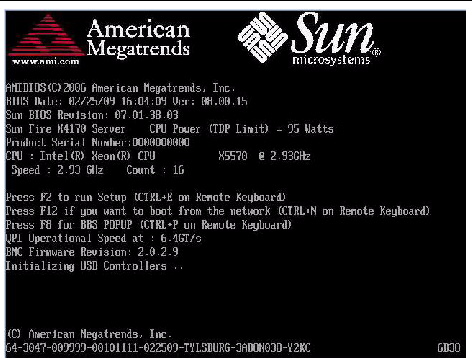
| Note - The next events occur very quickly; therefore, focused attention is needed for the following steps. Watch carefully for these messages as they appear on the screen for a brief time. You might want to enlarge the size of your screen to eliminate scroll bars. |
2. Press F8 to specify a temporary boot device.
The Please Select Boot Device menu appears.
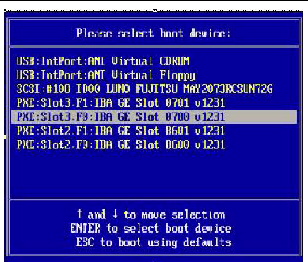
3. In the Please Select Boot Device menu, select the appropriate PXE installation boot device and press Enter.
The PXE installation boot device is the physical network port configured to communicate with your network installation server.
The Boot Agent dialog appears.
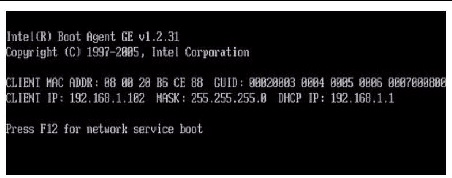
4. In the Boot Agent dialog, press F12 for a network service boot.
5. Continue the normal Windows Server 2008 WDS network installation. For additional information, consult Microsoft's Windows Deployment Services product documentation.
6. Proceed to Post Installation.
Copyright © 2009 Sun Microsystems, Inc. All rights reserved.
Source: https://docs.oracle.com/cd/E19432-01/820-7143-11/win2008.html
 Install Windows Server 2008 Using Local or Remote Media
Install Windows Server 2008 Using Local or Remote Media
0 Response to "92404i Setup Will Continue Windows 2008"
Post a Comment